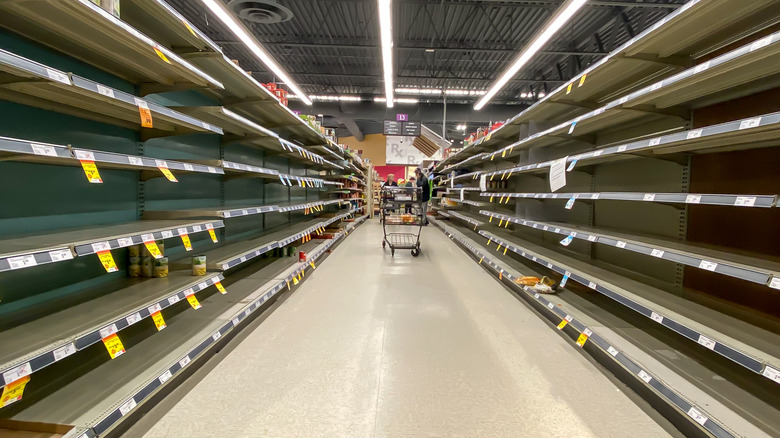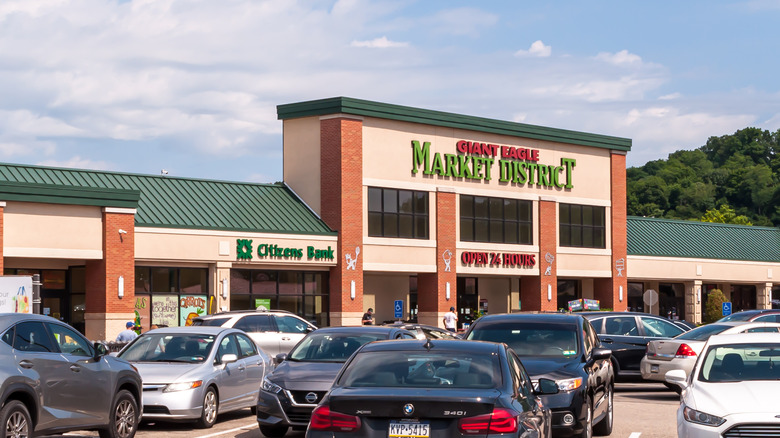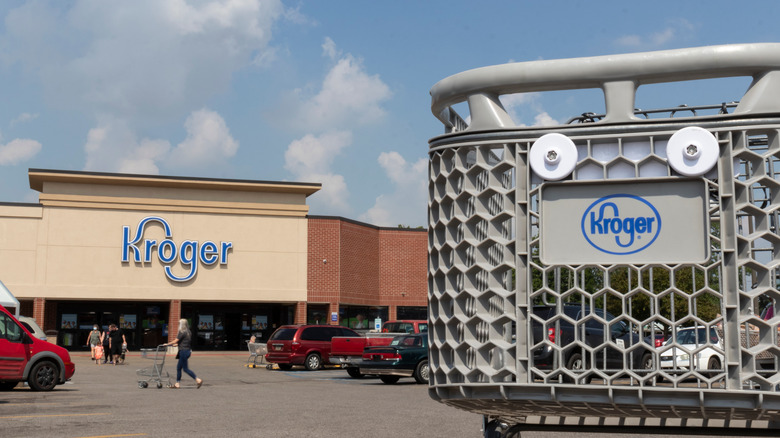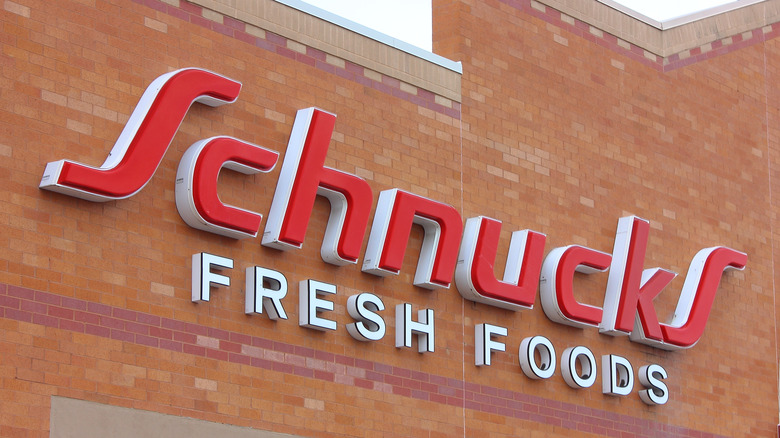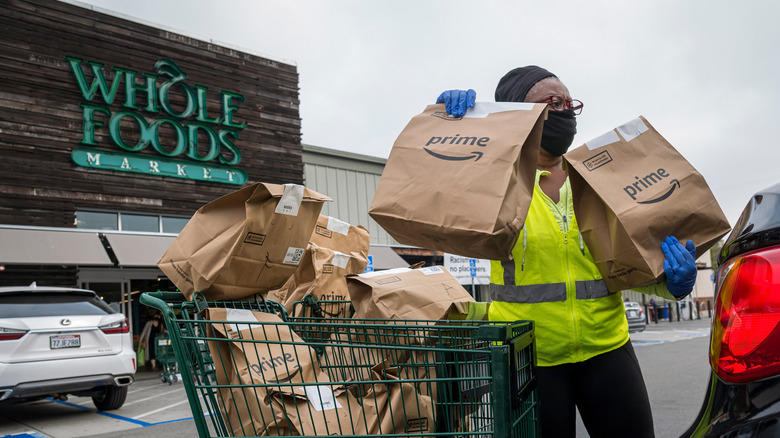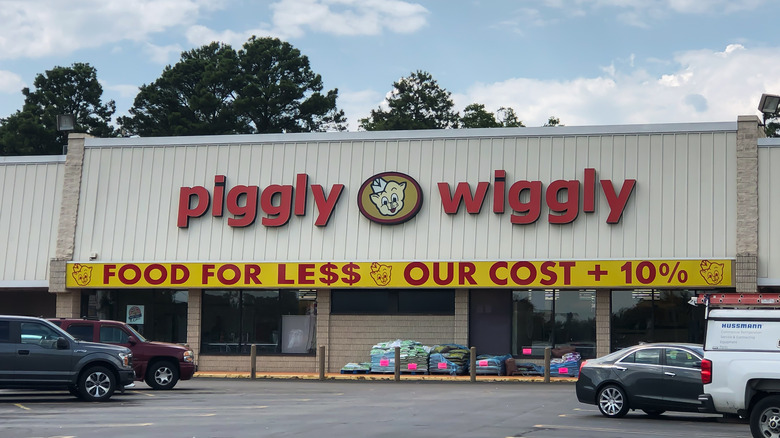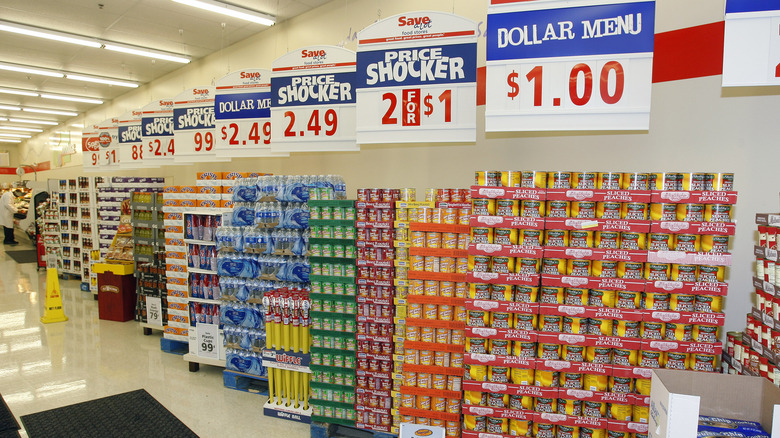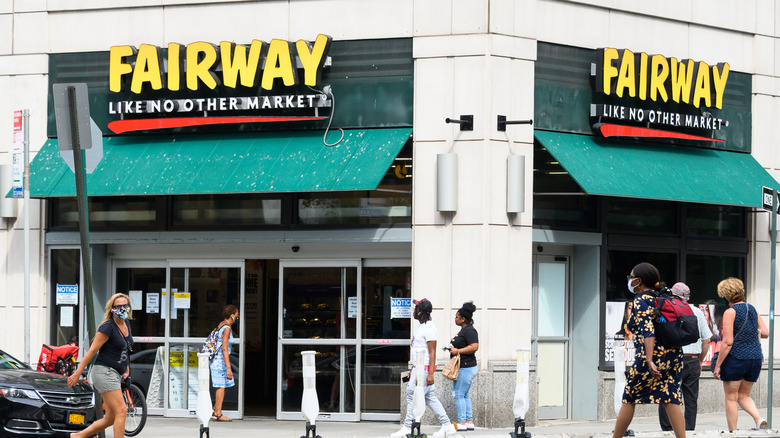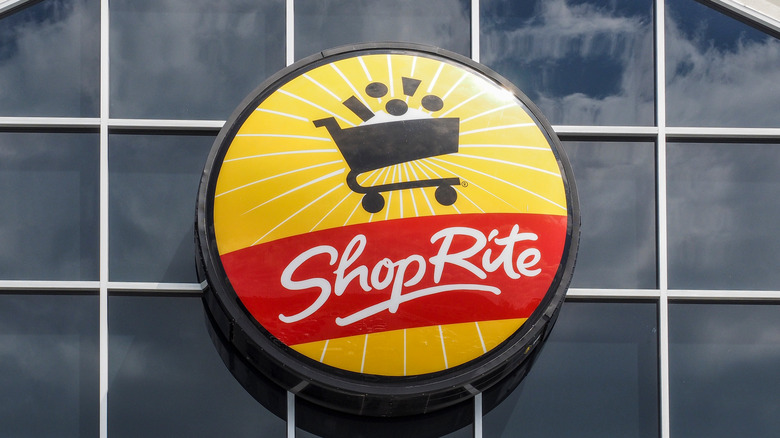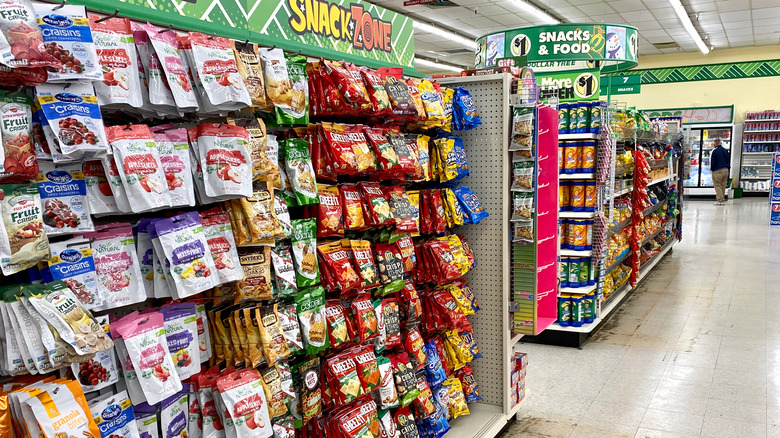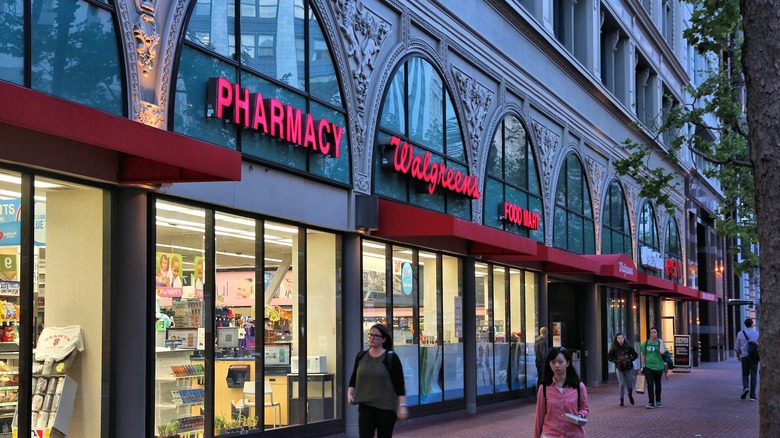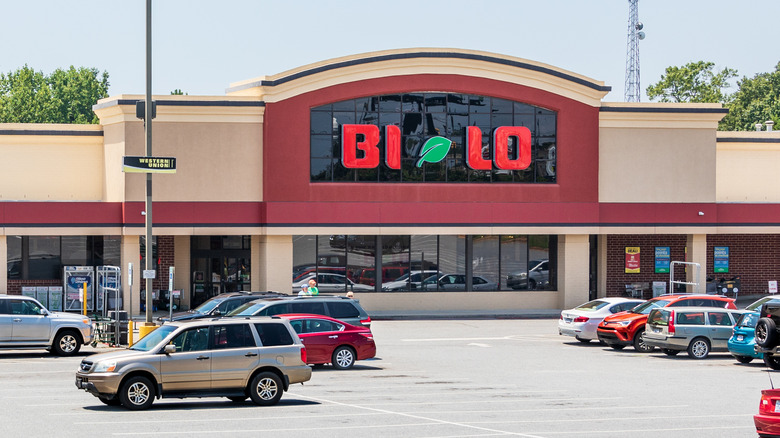Grocery Stores That Might Not Survive 2022
There's no doubt that 2021 has been an interesting year for grocery stores, to say the least. Since the beginning of the pandemic, consumers have changed their shopping habits, swapping in-store trips for convenient and safe online ordering. Others have stocked up on supplies in waves, cleaning out shelves at alarming rates. Stay-at-home orders in 2020 had people eating at home more than ever before, and the grocery industry had to adapt to meet their needs.
So, 2021 ended up being a year of tweaking business models to continue meeting those needs and rebound from the tumultuousness of the previous year. Some companies did more than survive; they thrived, thanks to increased food and beverage sales and the shift back to in-store shoppers, per Supermarket News.
Others didn't fare so well, particularly smaller companies that haven't been able to meet the increased demand of online grocery shoppers. Many retailers are also unable to keep their shelves stocked due to the current state of the nation's supply chain. Even some of the industry's biggest names have faced the closures of popular locations to downsize, cut costs, and reconfigure their business models. Here are some grocery stores that may face trouble in — and may not survive — 2022.
Giant Eagle
Since its founding in 1931, Giant Eagle has been a well-known name in the grocery industry, now garnering $9.7 billion in revenue among its 460+ primary and sub-brand locations. However, the company has faltered a bit the last year — as many grocery stores have — attempting to keep up with the evolution of online shopping and changing consumer needs.
For Giant Eagle, it's meant closing stores and restructuring others to prevent closure. In August 2021, NBC41 reported that a Columbus, Ohio location would shut down its 4,000-square-foot dining area because "there have been significant shifts in consumer shopping and dining interests that have led us to close the in-store restaurant," according to a company spokesperson.
Other Giant Eagle locations have shut their doors completely, including a beloved Beaver County, Pennsylvania store that has been a bright spot for the neighborhood for 25 years. According to The Times, Giant Eagle did not state the exact reason for the closure, but spokesman Dan Donovan encouraged shoppers to head to other stores in the area. A 30,000-square-foot location in Columbus's Schumaker Place neighborhood also saw its demise in early January 2021, reports Columbus Business First.
While closures aren't new to the company — it had a series of them throughout 2020 — the continued trend through 2021 leaves us wondering what its future might hold.
Kroger and Kroger Co. Brands
Kroger may be one of the biggest household brand names, but that doesn't make it immune to controversy. The company, best known for its private-label products, organic food selection, and perky rewards program, underwent pushback from its workers and loyal consumers when it vocalized its concerns about hazard pay for grocery workers. The payments, mandated in select jurisdictions, provide frontline workers with additional pay for their work throughout the COVID-19 pandemic.
In 2021, Kroger began shutting down locations in areas with hazard pay mandates, citing higher payroll, reduced margins, and a tough revenue balancing act, according to Forbes. Kroger stores aren't at the top of the list to go, though. Instead, it's Kroger Co.'s other brands, Ralphs and Food 4 Less, that are taking the hit. In the first quarter of the year alone, the company revealed seven closure announcements for its sub-brand locations across Los Angeles, Long Beach, and Seattle, all of which mandated hazard pay.
Moving closer to 2022, the company still appears to be struggling. Reuters reports that Kroger Co.'s shares declined a whopping 9.1%. The company places much of the blame on supply chain problems that Kroger Co. officials don't believe will soon correct themselves.
Schnucks
Known mostly in and around its birthplace of St. Louis, Missouri, Schnucks has more than 100 locations across its home state, Illinois, Indiana, Iowa, and Wisconsin. People across the United States may not be hit too hard with Schnucks's string of closures the last couple of years, but the areas its stores serve have been.
Starting near the end of 2019, Schnucks closed down three stores in the St. Louis metro area, primarily because of "poor sales," Progressive Grocer reports. However, the company also blamed those stores' lack of success on there being too many Schnucks stores in one area. However, the closures continued into 2020, shutting down a Bettendorf, Iowa, store, again due to lack of profits, CEO Todd Schnuck tells KWQC.
The new year brought even more closures for the company. Supermarket News reports that in February 2021, a Green Park, Missouri store served its customers one last time. In June, the company announced it would close its Shrewsbury, Missouri store for being less profitable than it had hoped when Schnucks acquired the building. By September 2021, Schnucks admitted that labor shortages forced the company to close many of its stores an hour earlier each day. Still, the small-town grocery chain remains hopeful that many employees will stick around and new ones will come aboard, announcing career fairs and a $600 retention bonus for eligible workers.
Whole Foods
Back in 2017, Amazon set out to acquire Whole Foods, a grocery store chain that prioritizes organic and natural foods and products, after it began to crumble under the pressure of newer, similar companies undercutting their prices. Amazon was successful, of course, and the merger seemed to be an incredible force in the grocery industry, at least initially. But the data has shown differently. Whole Foods makes up a large portion of Amazon's sub-brand brick-and-mortar locations. Managing director for GlobalData Neil Saunders says that Amazon's physical retail revenue fell by 16% year-over-year in the first quarter of 2021, also calling Whole Foods Amazon's "weak spot."
According to Business Insider, data from the end of 2020 also shows that Whole Foods stores had 21% less foot traffic than the previous year. While this could have been closely linked to people staying home more in the pandemic, there's also another issue that's likely at play: Whole Foods has yet to go online like many other modern grocery stores are doing.
Customers need to use Amazon Prime to order groceries online from Whole Foods, as Whole Foods has no proprietary ordering service. The problem? According to The Philadelphia Inquirer, in-store shoppers may find more crowded stores and long lines because of the Amazon Prime workers preparing orders for online customers, making for a less-than-ideal shopping experience.
Customers aren't the only ones frustrated with the company; its employees have negative opinions, too.
Piggly Wiggly
Branding itself as the first self-service supermarket in 1916, Piggly Wiggly pioneered the modern grocery shopping experience in which customers shop for themselves rather than having a clerk do it for them.
Despite its groundbreaking start and claim to fame, today, the company's stores only exist in 15 states, and some of its 500 locations have were left off its roster heading into 2021, like its Grantsboro, North Carolina, location. After 50 years, this store met its end in February, its owner Billy Flockhart citing that the store's proximity to other grocery stores was the primary problem. Another Piggly Wiggly in Aliceville, Alabama, closed in May after more than six decades in business to support its owner's retirement. And others, like the one in Dothan, Alabama, have had to shut their doors temporarily due to labor problems.
The future of Piggly Wiggly is up in the air at this point, with C&S Wholesale Grocers buying out 11 stores in the midwest, reports Supermarket News. While the acquisition details aren't public yet, Piggly Wiggly Midwest founder Paul Butera, Sr. says that "C&S has the experience and knowledge to ensure that this 100-year old icon continues for the next 100 years."
Save-A-Lot
The struggles for Save-A-Lot stores began a few years ago when it started losing money, eventually racking up more than $800 million in debt by August 2019, as reported by Bloomberg. In just the first two months of 2020, the grocer shut down seven stores in Delaware, Illinois, Florida, Indiana, and North Carolina to lower its debt and pull the company out of its lost revenue streak.
However, the rest of the year and the beginning of 2021 weren't too kind for Save-A-Lot, either. While the company successfully cut out about $500 million in debt, it had to sell several of its stores to get there and make deals with lenders and buyers to close others and sell stores to other companies to continue climbing out of the hole. Grocery Dive reports that as of January 2021, Save-A-Lot transferred 82 of its stores to new owners and still planned to sell more than 300 others.
One Dayton, Ohio location that shuttered in October 2021 was a particular upset to its customers. WHIO reports that the unexpected closure "shocked" its loyal customers, leaving many feeling as if Save-A-Lot failed the neighborhood and its need for quality foods.
Fairway Market
Since the 1930s, Fairway Market has served New York City with fresh foods at value prices. But in 2020, the retailer filed for Chapter 11 bankruptcy protection with plans to permanently close down five of its locations. According to CNBC, this was the second bankruptcy protection filing for the company, the first occurring in 2016 with a quick expansion that led to massive debt.
Essentially, small businesses like Fairway Market have difficulty keeping up with big-box grocers that feature vast buildings stocked with just about every food item on the planet and additional perks, like salad bars, hot food stations, and online grocery shopping. In Fairway Market's attempt to keep up, its overzealous expansion could have been its greatest downfall. Two more stores left the company later in 2020, becoming part of the Bogopa Service Corp. team.
To date, Fairway Market operates just five locations: four in New York City and one in Pelham Manor. However, CEO Abel Porter continues to remain optimistic about the company's future, telling CNBC that it continues to negotiate buyout contracts with other companies. "After careful consideration of all alternatives, we have concluded that a Court-supervised sale process is the best way to meet our objectives of preserving as many jobs as possible, maximizing value for our stakeholders, and positioning Fairway for long-term success under new ownership," says Porter.
ShopRite
It may be the largest employer in New Jersey, but ShopRite has had many wondering whether it will be able to continue competing with larger grocers after a series of store closures leading up to and through 2021.
In 2019, The Philadelphia Tribune reported that an Overbrook neighborhood ShopRite closed down, only for customers to learn that others in the area may soon be on their way to shutdowns, too. "I have two stores that are losing a substantial amount of money," owner Jeff Brown told the newspaper. "There's term left on their leases, but they're not financially viable in their current state with this [sweetened] beverage tax."
In 2021, ShopRite announced the closure of 62 of its in-store pharmacies, with spokeswoman Karen O'Shea pointing to pharmacy competition as the primary blame. According to O'Shea, "we were unable to sustain sufficient sales despite our marketing efforts." Other stores closed completely following the pharmacy closures, including the shocking closure of a Hudson Valley location and one in West Babylon, New York. The latter closed due to low, unsustainable sales.
Dollar Tree
Dollar Tree enthusiasts know that its stores have some enticing grocery aisles, with some locations even having full refrigerator and freezer sections for bargain grocery shopping. For more than three decades, the store has been a hit with consumers who visit to shop affordably for household goods, party supplies, and beauty and bath items, all for $1 or less. But 2021 gave many a surprise when Dollar Tree announced that it plans to raise its prices in 2022.
This isn't necessarily a completely new idea from the company, which turned some of its stores into Dollar Tree Plus locations with a selection of items over $1. By the end of 2021, the company plans to have some 1,500 Dollar Tree Plus stores. However, CNN reports that most prices will rise to $1.25 in all stores in the new year, even those not currently following the Dollar Tree Plus model. CEO Michael Witynski contributes the change to wage and cost increases that Dollar Tree needs to account for.
The hike isn't expected to go over well for the company's loyal customers, who have come to rely on the $1-per-item model. However, according to Business Insider, some experts believe that the pricing changes could lead to a better selection of higher-quality items that are still affordable. Time will tell how consumers receive the new Dollar Store model.
Walgreens
Walgreens is obviously more pharmacy than grocery store, but if you're needing a gallon of milk, loaf of bread, or some box macaroni and cheese to get through the weekend, it can surely suffice. It's the second-largest pharmacy chain in the United States based on market share in 2020, but that doesn't mean the company hasn't had its fair share of challenges. Walgreens has been on a bumpy roller coaster ride since 2015 when the chain closed about 200 locations to cut costs by $500 million. In 2018, Walgreens acquired more than 1900 Rite Aid stores, but CNBC reported in 2019 that 631 of those stores had since shut down, and Walgreens planned to close another 119 from the group. That same year, per CNBC, Walgreens announced its plans to close 200 U.K. stores and another 200 U.S. locations.
And the closures keep coming for the pharmacy giant, and in October 2021, Walgreens announced that it would shut down five stores in San Francisco due to a skyrocketing number of shoplifting incidents across the city's locations (via The Guardian). Other areas are also getting hit with Walgreens shutdowns too, including Syracuse, New York, and Berkeley, California.
BI-LO
BI-LO, a modest grocery chain founded in 1961 with locations in Georgia and the Carolinas, announced in early 2021 that it would be closing its doors for good. The move solidified what many were expecting, possibly even sooner than it happened, after filing for Chapter 11 bankruptcy protection in 2018. However, BI-LO emerged triumphantly, remodeling several of its stores soon after.
Still, the high didn't last long for the company, with its parent company, Southeastern Grocers, announcing the sale of 23 of its stores to other grocery companies, according to Supermarket News. The closures followed another announcement just a few months prior, in which Southeastern Grocers said it would sell 62 Harveys and BI-LO stores.
But 2021 marked the official end for BI-LO, with all stores slated to close by April. The company's statement on its website reads simply: "Thank you for 60 years! BI-LO is proud to say we have been a part of your family and traditions for the past six decades. It has been our honor to bring your community quality food and great prices. As we close our doors this year, we would like to say one final THANK YOU to everyone who we were able to serve."
All we can do is wait and see what 2022 holds for the other grocery chains on our list.
